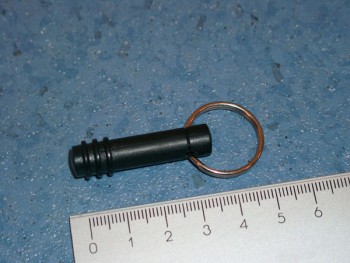What is RFID?
RFID stands for Radio Frequency Identification. By means of radio
signals, RFID can realize a contactless and unique identification of
persons and products on a short range.
To do this, RFID utilizes so-called transponders: electronic labels
in which the unique information is saved digitally. This digital
information can be read with a special reader unit.
Contrary to optical recognition (i.e. barcodes), transponders can be read invisible with the aid of radio signals.
Advantages of RFID
- Transponders last a very long time;
- Transponders are relatively cheap;
- Transponders don't need batteries;
- RFID Systems operate under extreme circumstances (i.e. cold / heat, pollution);
- Protection against vandalism;
- Transponders can be read from up until 1.5 metres (depending on the used reader & transponder types);
- Contactless recognition:
- RF signals can reach through non-ferrous materials (like plastics, glass, wood etc);
- The transponder can be placed so it's invisible to the user;
- The reader unit can be placed behind glass;
- There are no sparks, so this system can be used in areas with explosion danger such as petrol stations;
How does RFID work?

This is how RFID works, step by step (according to the diagram):
- A processor controls the RFID sender / receiver controller;
- An antenna sends high frequent energy with optional encoded information tot the transponder.
- In the transponder, the high frequent energy is being converted to an electrical charge, which is saved;
- This makes the transponder answer with its own, unique encoded information;
- The reader unit receives the transponder's answer; This information can be processed depending on the application.
What can we offer?
In the past twenty years, Rotil has built a tremendous expertise in
the area of RFID-applications. We have realized many solutions in the
listed areas (see below).
We develop the devices and the software according to our customer's
wishes and we adapt it to fit the operation circumstances (i.e. weather
conditions, robustness, explosion-dangerous areas)
Applications:
Please click at one of the applications below to read how Rotil
Communications B.V. applied these techniques successfully at previous
projects.
Other possibilities to apply the RFID technique are for example:
Vehicle identification
Every vehicle will carry a transponder. Through the unique id number
in the transponder it will be easy to ‘recognise’ the vehicle. This can
expanded with the registration of technical vehicle information such as
temperature, GPS location.
Logistic processes
Every container, box or crate has a transponder fitted to it. With
each step in the process, the transponder is being read and the
operation is saved in the central database. By this is, it will be very
easy to find out which steps in the production process has already been
made.
Service and maintenance
All products, devices or vehicles will get a transponder. The
service or maintenance mechanic scans this transponder for each
maintenance. The software on a computer, which is connected to a central
database, enables him to register for example the product details,
customer number, maintenance tasks, date/time. Now it will be much
easier to find out which maintenance or service has been provided to a
certain product/vehicle with just a click. This will be very (cost)
efficient.
Example software
Screenshot database application

Transponder types


http://www.rotil.nl/communications/products/rfid.en.php
 Need proof that China is a crucial smartphone market? Strategy Analytics is more than happy to oblige. It just posted third quarter global market share estimates showing that Huawei has overtaken LG since the Q2 report, claiming third place with 5.1 percent of sales. This isn't the first time that the Chinese phone maker has reached such lofty heights, but it comes even as LG produced stellar results; Huawei just happened to grow faster. Researchers attributed the rise to strong sales of its higher-end Ascend P6 and the mainstream G610, particularly in Huawei's home country.
Need proof that China is a crucial smartphone market? Strategy Analytics is more than happy to oblige. It just posted third quarter global market share estimates showing that Huawei has overtaken LG since the Q2 report, claiming third place with 5.1 percent of sales. This isn't the first time that the Chinese phone maker has reached such lofty heights, but it comes even as LG produced stellar results; Huawei just happened to grow faster. Researchers attributed the rise to strong sales of its higher-end Ascend P6 and the mainstream G610, particularly in Huawei's home country.




 Expand
Expand








